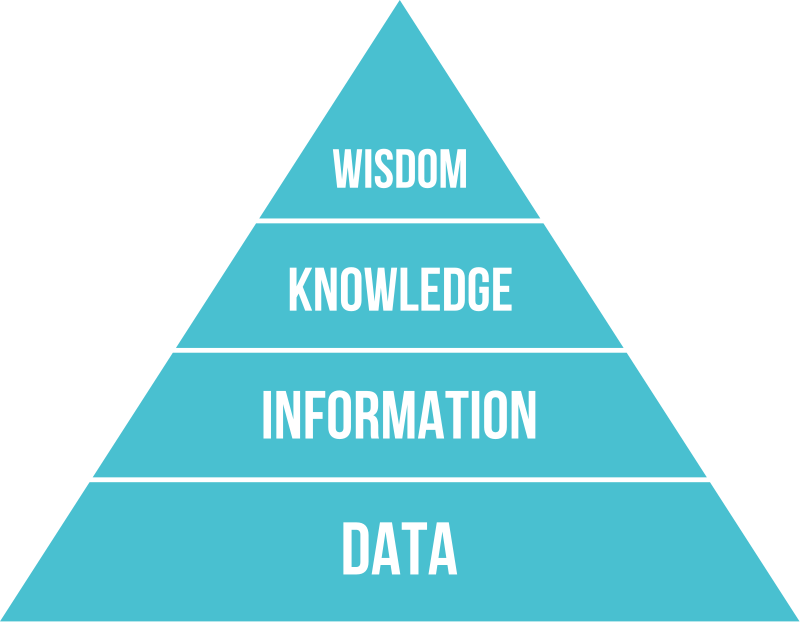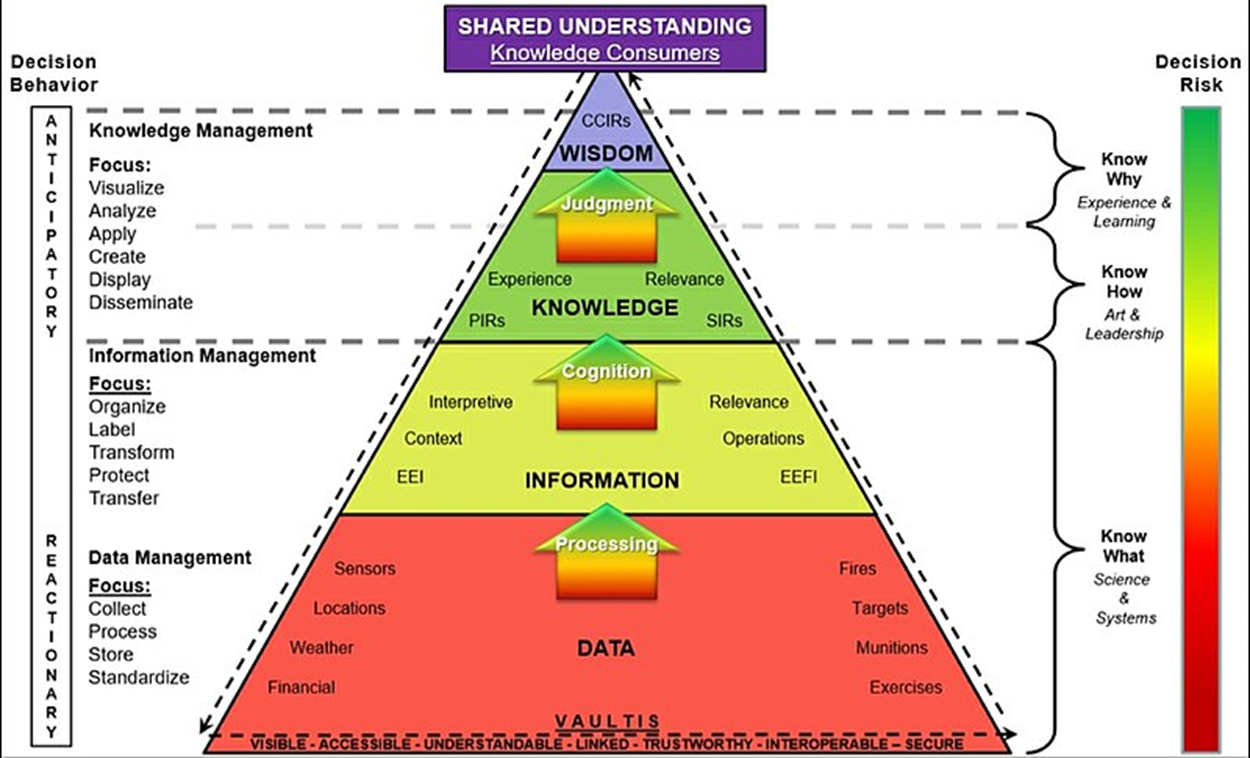Understanding the DIKW Model: From Data to Wisdom
Introduction
In today’s data-driven world, understanding how to effectively manage and utilize information is crucial for success in various fields. The DIKW (Data, Information, Knowledge, Wisdom) model, also known as the DIKW pyramid, is a well-established framework that helps individuals and organizations make sense of the vast amounts of data they encounter. This hierarchical model illustrates the relationships between data, information, knowledge, and wisdom, providing a structured approach to understanding and harnessing the value of each component.
The DIKW Hierarchy
The DIKW hierarchy is a pyramidal structure that represents the progression from raw data to actionable wisdom. Each layer of the pyramid builds upon the previous one, with data serving as the foundation and wisdom at the apex.

Data
Symbols, Facts, Measurements
Data is the raw, unprocessed facts and figures that are collected from various sources. It can be structured or unstructured, quantitative or qualitative, and may come from sensors, surveys, transactions, or any other means of observation. Data, on its own, lacks context and meaning, making it difficult to derive insights or make informed decisions. Examples of data include temperature readings from a weather station, customer purchase records from an e-commerce website, or pixel values in a digital image.
Data serves as the foundation of the DIKW hierarchy because it is the building block upon which information, knowledge, and wisdom are constructed. Without accurate and reliable data, the higher levels of the hierarchy cannot be achieved effectively. Therefore, organizations must focus on collecting, storing, and managing data efficiently to ensure a strong base for the subsequent layers.
Information
Data processed to be useful; provides the WHO, WHAT, WHEN, and WHERE.
Information is data that has been processed, organized, and given context, making it meaningful and useful for a specific purpose. It is derived from data by applying filters, aggregations, or transformations that highlight patterns, relationships, or trends. Information helps answer questions such as “who,” “what,” “where,” and “when,” providing insights that can guide decision-making processes.
Examples of information include a sales report that summarizes customer purchase patterns over a specific period, a weather forecast that predicts temperature and precipitation for the next few days, or a patient’s medical history that includes diagnosed conditions and prescribed treatments. The value of information lies in its ability to support decision-making, problem-solving, and communication within an organization.
Knowledge
Application of data and information; proides the HOW.
Knowledge is the understanding and application of information, gained through experience, learning, and interpretation. It involves the synthesis of multiple pieces of information, combined with an individual’s skills, expertise, and intuition. Knowledge enables people to make informed decisions, solve complex problems, and create new ideas or solutions.
There are two types of knowledge: tacit and explicit. Tacit knowledge is the personal, internalized understanding that is difficult to articulate or transfer to others. It is often developed through hands-on experience and practice. Explicit knowledge, on the other hand, is codified and easily shared through documents, manuals, or other formal means.
Examples of knowledge include a physician’s ability to diagnose a rare disease based on their extensive medical training and experience, an engineer’s expertise in designing a complex system by applying principles from multiple disciplines, or a marketer’s understanding of customer preferences and behavior based on analyzing market trends and consumer data.
Wisdom
Evaluated understanding; provides the WHY
Wisdom is the highest level of understanding and insight, achieved through the accumulation and application of knowledge over time. It involves a deep comprehension of the underlying principles, relationships, and implications of knowledge, combined with sound judgment, foresight, and ethical considerations. Wisdom enables individuals to make strategic decisions, anticipate future challenges, and provide guidance and leadership in their respective fields.
Wisdom is often associated with experience, intuition, and a holistic perspective. It involves not only knowing what to do but also understanding why it should be done and how it aligns with broader goals and values. Examples of wisdom include a senior executive’s ability to navigate complex organizational challenges and make decisions that balance short-term gains with long-term sustainability, a spiritual leader’s guidance on moral and ethical dilemmas, or a seasoned diplomat’s skills in negotiating peaceful resolutions to international conflicts.
Attaining wisdom is a lifelong process that requires continuous learning, reflection, and adaptation. It involves embracing uncertainty, learning from failures, and maintaining an open and curious mindset. While wisdom is highly valued, it is also the most difficult component of the DIKW hierarchy to achieve and measure.
Applications of the DIKW Hierarchy
The DIKW model has found applications in various domains, helping professionals make sense of complex data and information landscapes. Let’s explore how the DIKW hierarchy is applied in the biomedical domain and informatics.

Biomedical Domain
In the biomedical domain, the DIKW model is used to support healthcare delivery, medical research, and personalized medicine. Healthcare professionals collect vast amounts of patient data, including medical histories, lab results, and imaging studies. By applying the DIKW framework, they can transform this data into actionable information and knowledge to improve patient outcomes.
Case study 1: Using DIKW for personalized medicine In personalized medicine, healthcare providers use patient-specific data, such as genetic information and lifestyle factors, to tailor treatments and interventions. By integrating data from multiple sources and applying domain knowledge, physicians can make informed decisions about the most effective therapies for individual patients. This application of the DIKW model enables a more precise and targeted approach to healthcare delivery.
Case study 2: Applying DIKW in clinical decision support systems Clinical decision support systems (CDSS) assist healthcare professionals in making evidence-based decisions by providing relevant information and knowledge at the point of care. These systems leverage the DIKW hierarchy by collecting patient data, processing it into meaningful information, and applying medical knowledge to generate recommendations and alerts. CDSS helps reduce medical errors, improve adherence to clinical guidelines, and enhance the overall quality of patient care.
Informatics
Informatics, which encompasses fields such as data science, information science, and computer science, heavily relies on the DIKW model to manage and derive insights from large-scale data sets. Informatics professionals use various tools and techniques to collect, process, and analyze data, transforming it into information and knowledge that can drive decision-making and innovation.
Case study 1: Employing DIKW in data mining and knowledge discovery Data mining and knowledge discovery involve extracting hidden patterns, relationships, and insights from large datasets. By applying the DIKW model, data scientists can systematically process raw data, identify relevant information, and derive knowledge that can inform business strategies, scientific research, or policy decisions. For example, analyzing customer transaction data can reveal purchasing patterns and preferences, enabling businesses to develop targeted marketing campaigns and improve customer satisfaction.
Case study 2: Leveraging DIKW for information retrieval and recommendation systems Information retrieval and recommendation systems help users find relevant information and discover new content based on their preferences and behavior. These systems employ the DIKW hierarchy by collecting user data, such as search queries and browsing history, and using this information to generate personalized recommendations. By incorporating domain knowledge and user feedback, these systems can continuously improve their performance and provide more accurate and valuable suggestions to users.
Challenges and Future Directions
Despite its widespread adoption and usefulness, the DIKW model has faced some criticisms and limitations. One challenge is the lack of clear boundaries between the different components of the hierarchy. The distinction between data, information, knowledge, and wisdom can be subjective and context-dependent, making it difficult to apply the model consistently across different domains.
Another criticism is that the DIKW model oversimplifies the complex relationships between the components and does not adequately capture the iterative and non-linear nature of knowledge creation and application. Some argue that the model should be extended to include additional dimensions, such as context, experience, and creativity, to better reflect the dynamic nature of knowledge and decision-making processes.
Future research directions could focus on refining the DIKW model to address these limitations and explore new applications in emerging fields, such as big data analytics, artificial intelligence, and the Internet of Things. Researchers could also investigate how the DIKW hierarchy can be integrated with other frameworks, such as the knowledge management cycle or the data science pipeline, to create more comprehensive and effective approaches to managing and utilizing information assets.
Conclusion
The DIKW model provides a valuable framework for understanding the progression from raw data to actionable wisdom. By breaking down the components of the hierarchy and exploring their characteristics and relationships, we can better appreciate the importance of each stage in the knowledge creation process. The practical applications of the DIKW model in the biomedical domain and informatics demonstrate its versatility and relevance in today’s data-intensive world.
As we continue to generate and collect vast amounts of data, the DIKW model will remain a crucial tool for organizations and individuals seeking to harness the power of information and knowledge. By embracing the principles of the DIKW hierarchy and adapting it to meet the challenges and opportunities of the digital age, we can unlock new insights, drive innovation, and make better-informed decisions in our personal and professional lives.

This post was written with the help of Claude 3 Opus.

Leave a comment